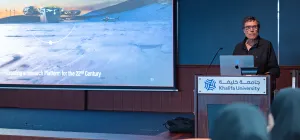A Strong Start for Science This Season
Field expeditions for the FROID and ULTIMO projects are off to a strong start, with other scientific projects stopping by the station this week.

Field expeditions for the FROID and ULTIMO projects are off to a strong start, with other scientific projects stopping by the station this week.
Following their arrival at the Princess Elisabeth Antarctica station at the beginning of December, the scientific teams from the FROID and ULTIMO projects spent a week undergoing the required field training and preparation before heading out into the field to start their work.
And they’re off!!
After the IPF team spent weeks preparing the logistics for the scientific expeditions, last Saturday, December 7th, the FROID team left the Princess Elisabeth Antarctica to spend a month in the field on their respective research missions this season.
The FROID project headed out to the Niels Larsen Blue Ice Field and has been camped out there for several days. They’ve started to drill shallow 10-metre ice cores and perform radar observation of the ice and the bedrock.
The Niels Larsen Blue Ice Field’s ice has been produced by millennia of precipitation accumulation and compaction and is believed to be pushed up by the nearby Sør Rondane Mountains. Gravity forces ice in the continental ice sheet to flow towards the coast, and when it encounters mountains, they force the bottom layers of ice closer to the surface, making it easier to access older ice without having to drill several kilometres down into the ice sheet.
This season, the project only plans to test the coin techniques. Next season, they hope to return and drill ice cores deep enough to find ice layers that are more than one million years old. The air trapped in the bubbles that can be found in these ice layers give information about what the atmosphere looked like a million years ago on our planet.
A stop along the way
And on Monday, December 9th, the ULITIMO - project left in a caravan of two Prinoth tractors and several living containers.
While their ultimate goal is to reach Mont Belgica to try and find meteorites there, the team spend two days at Balchenfjella (eastern Sør Rondane Mountains) along the way, nearly 200 km from PEA. While there, the ULTIMO project team scoured the area for meteorites, as six years ago Steven Goderis from the VUB had found quite of few there. So far, four meteorites have been found by the team, which is not a bad start.
BELARE leader Alain Hubert took advantage of this time to go ahead to try and find a safe path along the remaining 120 km to Mont Belgica. The area ahead is filled with crevasses, so Alain’s decades of experience will come in handy as they progress. Hopefully the weather will remain clear for a few more days to allow them to reach their destination under good conditions!
Return of old friends
This week also saw the return of scientists and technicians from the Alfred Wegener Institute on their Polar 6 Basler plane. The team and the pilots will be spending a couple of weeks at PEA so they can continue taking transects at the coast of Queen Maud Land along the grounding line for the RINGS project, which has as its primary objective to develop a comprehensive reference bed topography dataset around the entire Antarctic coast. This will help scientists understand the processes responsible for current ice discharge, potential future ice-sheet retreat, and sea level rise.
Two Danish scientists form the SWIDA-Rings project (a part of the same international RINGS project) also visited the station with a Twin Otter to perform radar observations of the ice sheet around the southwestern part of the Sør Rondane Mountains. These data will be very valuable for the FROID project currently working in the area.
Seasonal maintenance
Meanwhile, the IPF team at the station has been doing seasonal maintenance of the wind turbines. One by one they’ve been lowering them and replacing worn parts before raising them back up and, ready for a new winter season ahead.
And for the PEACE project, Simon Steffen and Nicolas Herinckx are getting ready to install new parts on the series of automatic weather stations along the 250 km transect the project covers, from the Antarctic Plateau to the coast next week. They hope to service most if not all of the six stations in the project this season and install new CR3000 data loggers.
There’s going to be a lot of action until Christmas!
Download





















